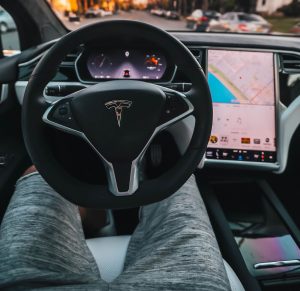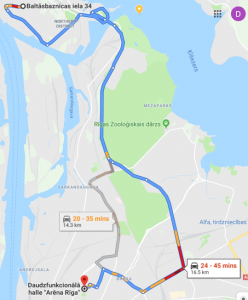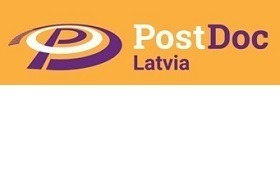Author: Dmitry Pavlyuk

Imagine you are driving to a decisive ice hockey match in Riga in the nearest future. You sit a comfortable seat of your self-driving car and ask it for your destination. The super-intelligent on-board computer collects forecasts from the best-ever urban traffic forecasting service and chooses the optimal uncongested route. Now it’s time to relax and enjoy a short trip to Arena Riga, where your favourite team (Dinamo Riga, of course) is preparing for their first Grand Final…
But – stop! – a terrible traffic congestion on your way deprive you of the first and the most fascinating period of the match!
What’s happened? Has the best-ever traffic forecasting service made a terrible mistake? It seems not – it just has recommended the same optimal uncongested route to other 10,000 fans as well…
The case is not fantastic – if you drive frequently, you already got into a situation when, trying to go around the traffic jam and following an advice of your intelligent navigator, you find yourself in the ever-larger traffic jam in an unexpected place. The growing number of self-driving cars, which tend to follow the advised route directly, will just increase the frequency of such cases.
This problem is not resolvable within traffic forecasting services, which provide independent advices for all drivers. Thus, the services will be forced to communicate to each other in the nearest future.
 Firstly, let’s define what is the traffic forecasting service, and why we don’t have “the best” one. The traffic forecasting service includes three key components:
Firstly, let’s define what is the traffic forecasting service, and why we don’t have “the best” one. The traffic forecasting service includes three key components:
- City-wide real-time data on traffic conditions,
- An algorithm of traffic forecasting (usually based on a model), and
- Software that delivers forecasts to end users.
Surprisingly, the algorithms are the most open component of traffic forecasting: there plenty of scientific studies devoted to development, testing, and optimisation of urban traffic forecasting models and algorithms, and many of them are supported by open source implementations. Thus, development of traffic forecasting products is concentrated in companies and government bodies that control traffic data or distribute navigation software. Most frequently, traffic forecasting services are embedded into car navigation software (e.g. TomTom, Waze, Google Maps) or into city traffic control systems (e.g. PTV or Aimsun).
The antimonopoly regulation has not come into this sphere yet – the end user buys the product “all-in-one” and cannot choose the preferable forecasting model in his car navigation software or in the city traffic control system. Looking into antimonopoly wars against Google and Microsoft, we expect that the traffic forecasting services will gain their independence too. Soon the end users will choose the preferable traffic forecasting service with a couple of clicks – like we choose a weather forecast provider in our smartphones now.
When the open market of traffic forecasting services will be formed, their providers will have to follow two usual market strategies – compete or cooperate.
Scenario 1. Competing traffic forecasts
In this scenario, several traffic forecasting service providers will fight for the end users. This means something more interesting than regular campaigns that we already have on the navigation software market – the automated forecasting service will need to learn and predict forecasts of their competitors. The good forecasting algorithm will predict not only the urban traffic itself, but also recommendations of competing algorithms. So, the winning algorithm will be able to predict behaviour of drivers that follow recommendations of other services and construct the optimal route for its own users.
This competition of non-so-simple traffic forecasting algorithms will make them even more complicated. Algorithm development will become more challenging yet attractive task with intensive application of modern math tools of competition and equilibrium – e.g. the game theory[i].
Scenario 2. Cooperative traffic forecasts
The opposite scenario opens the ways for cooperation between traffic forecasting services. Once the services will share the information about their forecasts and recommendations, urban traffic flows will become more predictable and usage of road infrastructure – more optimal for the end users. Centralised usage of information on actual traffic flows and recommendations from the traffic forecasting services could be materialised in a modern concept of a digital twin[ii]. The digital twin contains a detailed information about the road infrastructure and real-time traffic flows enhanced by the predicted traffic states, incident management plans, etc. Within the digital twin, all infrastructure (traffic lights), forecasting algorithms and navigation software units play as a good orchestra, optimising the traffic flows at the city-wide level.
Looks like a dream of traffic engineers? Yes. But there is nothing fantastic here, so if we strive for a dream, it will come true.
 No matter which scenario will be implemented, efficient city-wide traffic forecasting algorithms will be in demand. That’s why LaTDEA Association supports research projects in this area, including the research project No. 1.1.1.2/VIAA/1/16/112 “Spatiotemporal urban traffic modelling using big data”[iii], executed by Dmitry Pavlyuk, Transport and Telecommunication Institute[iv] and implemented under the specific support objective activity 1.1.1.2. “Post-doctoral Research Aid” (Project id. N. 1.1.1.2/16/I/001) of the Republic of Latvia, funded by the European Regional Development Fund.
No matter which scenario will be implemented, efficient city-wide traffic forecasting algorithms will be in demand. That’s why LaTDEA Association supports research projects in this area, including the research project No. 1.1.1.2/VIAA/1/16/112 “Spatiotemporal urban traffic modelling using big data”[iii], executed by Dmitry Pavlyuk, Transport and Telecommunication Institute[iv] and implemented under the specific support objective activity 1.1.1.2. “Post-doctoral Research Aid” (Project id. N. 1.1.1.2/16/I/001) of the Republic of Latvia, funded by the European Regional Development Fund.
[i] Ben-Porat, O., Tennenholtz, M., Competing Prediction Algorithms https://arxiv.org/abs/1806.01703
[ii] https://www.citylab.com/transportation/2019/07/digital-twin-mobility-data-standard-city-real-time-traffic/593914/
[iii] https://www.researchgate.net/project/Spatiotemporal-urban-traffic-modelling-using-big-data
Image source: www.pexels.com, CC0 license
